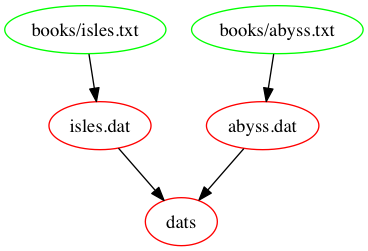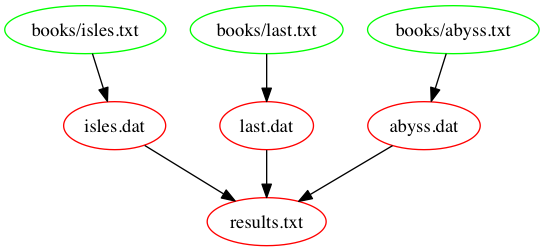Makefiles
Overview
Teaching: 30 min
Exercises: 10 minQuestions
How do I write a simple Makefile?
Objectives
Recognize the key parts of a Makefile, rules, targets, dependencies and actions.
Write a simple Makefile.
Run Make from the shell.
Explain when and why to mark targets as
.PHONY.Explain constraints on dependencies.
Create a file, called Makefile, with the following content:
# Count words.
isles.dat : books/isles.txt
python countwords.py books/isles.txt isles.dat
This is a build file, which for Make is called a Makefile - a file executed by Make. Note how it resembles one of the lines from our shell script.
Let us go through each line in turn:
#denotes a comment. Any text from#to the end of the line is ignored by Make.isles.datis a target, a file to be created, or built.books/isles.txtis a dependency, a file that is needed to build or update the target. Targets can have zero or more dependencies.- A colon,
:, separates targets from dependencies. python countwords.py books/isles.txt isles.datis an action, a command to run to build or update the target using the dependencies. Targets can have zero or more actions. These actions form a recipe to build the target from its dependencies and can be considered to be a shell script.- Actions are indented using a single TAB character, not 8 spaces. This is a legacy of Make’s 1970’s origins. If the difference between spaces and a TAB character isn’t obvious in your editor, try moving your cursor from one side of the TAB to the other. It should jump four or more spaces.
- Together, the target, dependencies, and actions form a rule.
Our rule above describes how to build the target isles.dat using the
action python countwords.py and the dependency books/isles.txt.
Information that was implicit in our shell script - that we are
generating a file called isles.dat and that creating this file
requires books/isles.txt - is now made explicit by Make’s syntax.
Let’s first ensure we start from scratch and delete the .dat and .png
files we created earlier:
$ rm *.dat *.png
By default, Make looks for a Makefile, called Makefile, and we can
run Make as follows:
$ make
By default, Make prints out the actions it executes:
python countwords.py books/isles.txt isles.dat
If we see,
Makefile:3: *** missing separator. Stop.
then we have used a space instead of a TAB characters to indent one of our actions.
Let’s see if we got what we expected.
head -5 isles.dat
The first 5 lines of isles.dat should look exactly like before.
Makefiles Do Not Have to be Called
MakefileWe don’t have to call our Makefile
Makefile. However, if we call it something else we need to tell Make where to find it. This we can do using-fflag. For example, if our Makefile is namedMyOtherMakefile:$ make -f MyOtherMakefileSometimes, the suffix
.mkwill be used to identify Makefiles that are not calledMakefilee.g.install.mk,common.mketc.
When we re-run our Makefile, Make now informs us that:
make: `isles.dat' is up to date.
This is because our target, isles.dat, has now been created, and
Make will not create it again. To see how this works, let’s pretend to
update one of the text files. Rather than opening the file in an
editor, we can use the shell touch command to update its timestamp
(which would happen if we did edit the file):
$ touch books/isles.txt
If we compare the timestamps of books/isles.txt and isles.dat,
$ ls -l books/isles.txt isles.dat
then we see that isles.dat, the target, is now older
thanbooks/isles.txt, its dependency:
-rw-r--r-- 1 mjj Administ 323972 Jun 12 10:35 books/isles.txt
-rw-r--r-- 1 mjj Administ 182273 Jun 12 09:58 isles.dat
If we run Make again,
$ make
then it recreates isles.dat:
python countwords.py books/isles.txt isles.dat
When it is asked to build a target, Make checks the ‘last modification time’ of both the target and its dependencies. If any dependency has been updated since the target, then the actions are re-run to update the target. Using this approach, Make knows to only rebuild the files that, either directly or indirectly, depend on the file that changed. This is called an incremental build.
Makefiles as Documentation
By explicitly recording the inputs to and outputs from steps in our analysis and the dependencies between files, Makefiles act as a type of documentation, reducing the number of things we have to remember.
Let’s add another rule to the end of Makefile:
abyss.dat : books/abyss.txt
python countwords.py books/abyss.txt abyss.dat
If we run Make,
$ make
then we get:
make: `isles.dat' is up to date.
Nothing happens because Make attempts to build the first target it
finds in the Makefile, the default
target, which is isles.dat which is
already up-to-date. We need to explicitly tell Make we want to build
abyss.dat:
$ make abyss.dat
Now, we get:
python countwords.py books/abyss.txt abyss.dat
“Up to Date” Versus “Nothing to be Done”
If we ask Make to build a file that already exists and is up to date, then Make informs us that:
make: `isles.dat' is up to date.If we ask Make to build a file that exists but for which there is no rule in our Makefile, then we get message like:
$ make countwords.pymake: Nothing to be done for `countwords.py'.
up to datemeans that the Makefile has a rule with one or more actions whose target is the name of a file (or directory) and the file is up to date.
Nothing to be donemeans that the file exists but either :
- the Makefile has no rule for it, or
- the Makefile has a rule for it, but that rule has no actions
We may want to remove all our data files so we can explicitly recreate
them all. We can introduce a new target, and associated rule, to do
this. We will call it clean, as this is a common name for rules that
delete auto-generated files, like our .dat files:
clean :
rm -f *.dat
This is an example of a rule that has no dependencies. clean has no
dependencies on any .dat file as it makes no sense to create these
just to remove them. We just want to remove the data files whether or
not they exist. If we run Make and specify this target,
$ make clean
then we get:
rm -f *.dat
There is no actual thing built called clean. Rather, it is a
short-hand that we can use to execute a useful sequence of
actions. Such targets, though very useful, can lead to problems. For
example, let us recreate our data files, create a directory called
clean, then run Make:
$ make isles.dat abyss.dat
$ mkdir clean
$ make clean
We get:
make: `clean' is up to date.
Make finds a file (or directory) called clean and, as its clean
rule has no dependencies, assumes that clean has been built and is
up-to-date and so does not execute the rule’s actions. As we are using
clean as a short-hand, we need to tell Make to always execute this
rule if we run make clean, by telling Make that this is a
phony target, that it does not build
anything. This we do by marking the target as .PHONY:
.PHONY : clean
clean :
rm -f *.dat
If we run Make,
$ make clean
then we get:
rm -f *.dat
We can add a similar command to create all the data files. We can put
this at the top of our Makefile so that it is the default
target, which is executed by default
if no target is given to the make command:
.PHONY : dats
dats : isles.dat abyss.dat
This is an example of a rule that has dependencies that are targets of other rules. When Make runs, it will check to see if the dependencies exist and, if not, will see if rules are available that will create these. If such rules exist it will invoke these first, otherwise Make will raise an error.
Dependencies
The order of rebuilding dependencies is arbitrary. You should not assume that they will be built in the order in which they are listed.
Dependencies must form a directed acyclic graph. A target cannot depend on a dependency which itself, or one of its dependencies, depends on that target.
This rule is also an example of a rule that has no actions. It is used purely to trigger the build of its dependencies, if needed.
If we run,
$ make dats
then Make creates the data files:
python countwords.py books/isles.txt isles.dat
python countwords.py books/abyss.txt abyss.dat
If we run dats again, then Make will see that the dependencies (isles.dat
and abyss.dat) are already up to date.
Given the target dats has no actions, there is nothing to be done:
$ make dats
make: Nothing to be done for `dats'.
Our Makefile now looks like this:
# Count words.
.PHONY : dats
dats : isles.dat abyss.dat
isles.dat : books/isles.txt
python countwords.py books/isles.txt isles.dat
abyss.dat : books/abyss.txt
python countwords.py books/abyss.txt abyss.dat
.PHONY : clean
clean :
rm -f *.dat
The following figure shows a graph of the dependencies embodied within
our Makefile, involved in building the dats target:

Write Two New Rules
- Write a new rule for
last.dat, created frombooks/last.txt.- Update the
datsrule with this target.- Write a new rule for
results.txt, which creates the summary table. The rule needs to:
- Depend upon each of the three
.datfiles.- Invoke the action
python testzipf.py abyss.dat isles.dat last.dat > results.txt.- Put this rule at the top of the Makefile so that it is the default target.
- Update
cleanso that it removesresults.txt.The starting Makefile is here.
Solution
See this file for a solution.
The following figure shows the dependencies embodied within our
Makefile, involved in building the results.txt target:

Key Points
Use
#for comments in Makefiles.Write rules as
target: dependencies.Specify update actions in a tab-indented block under the rule.
Use
.PHONYto mark targets that don’t correspond to files.